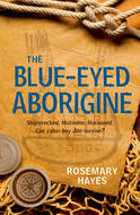The blue-eyed Aborigine by Rosemary Hayes

Frances Lincoln Children's Books, 2010. ISBN 978 1847800787.
Highly recommended. Suggested for readers 13 plus.
This historical novel gives an excellent account of the wrecking of the
Batavia when she struck a reef on the Abrohols Islands, half way down
the coast of Western Australia in 1629. Related principally from the
perspective of a cabin boy, Jan de Bye, part one of the story deals
with the atrocities which occurred amongst survivors who found
themselves under the command of the insane Jeronimus Corneliusz.
Commander Pelseart and Captain Jacobs had taken the longboat to search
for water but finding themselves a long way North, decided to continue
to Java to arrange rescue for the rest of the survivors. Jacobs and
Corneliusz had previously conspired to mutiny and seize the vessel and
its astonishingly valuable cargo, in order to live a buccaneering life.
In their absence, Corneliusz, an apothecary who had secured himself a
position as senior merchant for the Dutch East Indies Company on the
trading venture to Java, commenced his rule of terror. Murder, torture
and rape was conducted on an horrific scale and any who resisted were
considered traitors and enemies. In this fashion, the boy Jan, finds
himself involved in the sickening exploits, participating in acts
previously unimaginable. Incredibly Pelseart returned from Java within
two months and the mutineers met their fate. Because the rescue vessel
would have been overcrowded with the survivors and prisoners, many of
mutineers were tried and executed on the islands. Because of his age
and the fact that he had been influenced by Corneliusz, Jan's death
sentence was commuted along with that of Wouter Loos, who despite being
a murderer had tried to protect Lucretia Van der Meylen, a noblewoman
passenger. The fate of this pair was to be set adrift in a small boat
with meager supplies when Pelseart took the survivors to Java. The
novel to this point is based on sound historical fact but part two is
pure fiction as the fate of these individuals is unknown. Hayes
presents a wholly plausible narrative of the exploits of Jan and Wouter
(who were probably the first Europeans to land on mainland Australia)
as they seek to survive in this barren region. Hayes portrays
Aboriginal characters in a realistic and sensitive manner and creates
an outcome which is quite possible, maybe probable. Having read many
accounts of this tragic episode, I was impressed by the author's
research and skill in relating history whilst telling a captivating
tale. Necessarily for younger adolescents, many explicit details are
avoided and the violence and degradation are described as moderately as
possible.
Rob Welsh